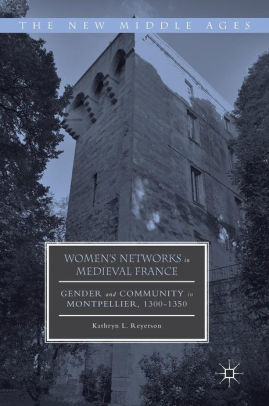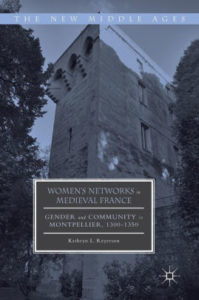
Women’s Networks in Medieval France: Gender and Community in Montpellier, 1300-1350 by Kathryn L. Reyerson
 This book presents a broad-ranging description of women’s social and familial networks in medieval Southern France through the archival traces left by a single woman, Agnès de Bossones (d.1342), a wealthy widow of Montpellier. The book opens with a close study of Agnes’s life and family as they are revealed in her will (transcribed and translated in full in Appendix 5), then spirals outwards, with its last chapters offering case studies of groups of women with whom Agnes interacted as landlord and benefactor. These include market sellers and prostitutes, both listed in two other Appendices. Reyerson’s meticulous, detailed enquiry reconstructs both the official and the marginal elements in a complex urban web.
This book presents a broad-ranging description of women’s social and familial networks in medieval Southern France through the archival traces left by a single woman, Agnès de Bossones (d.1342), a wealthy widow of Montpellier. The book opens with a close study of Agnes’s life and family as they are revealed in her will (transcribed and translated in full in Appendix 5), then spirals outwards, with its last chapters offering case studies of groups of women with whom Agnes interacted as landlord and benefactor. These include market sellers and prostitutes, both listed in two other Appendices. Reyerson’s meticulous, detailed enquiry reconstructs both the official and the marginal elements in a complex urban web.
The daughter and wife of a money changer, a rising industry in Montpellier, Agnès died the matriarch of an elite family. Montpellier was a major hub for international trade between the Rhône Valley and the Italian and Iberian peninsulas. It was a complex place, strong on legal experts, as was the norm in Occitan-speaking regions. The city had been under the rule of the kings of Aragon since the early thirteenth century and had more recently become the chief port for the Aragonese kingdom of Mallorca. Separate from the bishop’s seat (civitas) at Maguelone, the town had a nominal episcopal quarter, bought by the king of France in 1293. The inhabitants of Montpellier used two law courts that depended respectively on French and Mallorcan royal authority. Agnès’s husband and son-in-law acquired the higher status of burgensis (bourgeois). Even this title reflects a complex social system. Burgenses were named through formal processes of appointment strictly tied to the district inhabited by the new burgher, and the title was conferred by the king of France to men in his sector (burgenses parti regis), to others by the royal administrator, and in a few cases by the Mallorcan rulers. As in other cities, immigrants could obtain the title too, if they were prominent merchants from nearby cities, Tuscany, Lombardy, or Cyprus.
The book uses Agnès as a focal point in this multiple urban space. She emerges as well-suited to her environment, a skilled businesswoman, landlord, possibly a banker. Agnès’s first surviving appearance in documents dates from 1301, when she was a widowed mother of three girls, and she grew her personal and family wealth until she died in 1342, naming fifteen grandchildren in her ten-page will. As guardian (tutrix) to her daughters, Agnès enjoyed considerable financial autonomy, and she never remarried. She had dealings in person with the city’s overlapping law courts. She displays traits that Reyerson describes as typical of high-status women of this time and region: “Widows could be aggressive” in legal processes, because they “had property and family patrimony to protect” (17). Reyerson suggests that the absence of women’s names from the city’s commercial and financial records unless they were widows reflects legal conventions more than any actual disconnection from their families’ line of business.
Chapter Two explores Agnès’s will of 1342 for evidence of her family and personal network. Her daughters had married a merchant draper, a lawyer and a member of the urban nobility. The elite family network clearly played a part but in medieval Montpellier, no woman married without a dowry (54). She had made lucrative marriages possible by investing in property that she rented out for trade and housing, as is shown in Chapter Three, which examines Agnès as a real estate “entrepreneur.” Her own mansion (probably three-storied, with a painted interior) sat at the heart of the town’s money changing district. Reyerson examines her family’s dispute with the consuls over a town square because Agnès had bought and leased out houses sitting around it, the tradeswomen’s stalls that were active within it, and the ground space of the square itself. It is interesting to see that the square and its appurtenances were an investment purchase by Agnès to fund the dowry of one of her daughters. Another point of interest is Agnès’s protective treatment of bequests she left to grand-daughters who were nuns. It seems that her energies were devoted over forty years to controlling and protecting the financial interests of the female line of descent.
The dowry system ensured that a woman could in principle retain control of a portion of her fortune as long as she lived. Reyerson cites a few instances of women arranging their own marriages or acting only with their mothers (this increased in the Plague crisis of 1347-48). The norm however was that a woman’s male relatives provided their consent collectively to a match. Widows seem to remarry relatively rarely—only seven out of 132 marriage contracts, (58), and male remarriage is hardly ever noted in documents. In legal and no doubt social practice, women from prominent families were not in control of their marital and emotional destinies, yet the archival evidence for individuals such as Agnès de Bossones reveals different experiences.
Chapter Four uses marital networks further as a tool for identifying more expansive dynamics of Montpellier’s urban society. Reyerson notes that immigration and apprenticeships provided opportunities for expanding and strengthening networks through marriage, functioning as a “community-building exercise” (49). Chapter Five explores apprenticeships for men and for women as a way of supporting the suggestion that Agnès might have worked as a deposit banker. Reyerson traces women apprentices and businesswomen in the food and textile trades (notably mercers). Apprenticed girls enjoyed a delayed age of marriage as well as greater autonomy, possibly greater mobility, than they would otherwise have had. Chapter Six provides a broader survey of the investments and loans that knitted rural production and urban manufacturing and trade. These three chapters place the economic activities of money changers and deposit bankers in their context, as the pillars of exchanges between trading partners, communities and industries. A stable family with a hold over urban property such as Agnès’s was only possible thanks to the social and geographical mobility of others.
Chapter Seven narrows its focus to the market place of the Herbaria, the object of the family dispute with the consuls over ownership. The court case elicited fifteen witness statements from women traders who rented stalls there, and they reveal a stable network of middle-aged and elderly women, tied to wealthier women such as Agnès who could also offer a form of protection. A will left by one of these market vendors shows that some were sufficiently wealthy to leave bequests that supported other, presumably poorer, women. Chapter eight turns to another location, a road leading to the seashore, and to another aspect of women’s retail activity in Montpellier. Prostitution was legitimized (or at least less condemned) in late-medieval Southern France and Agnès left bequests to houses of repentant prostitutes. Reyerson’s study of transactions concerning the road known as Campus Polverel identify twenty-five women who rented houses there for use as brothels. She stresses that these women are sometimes identified by paternal lineage, but also that they appear as women from other towns, or as lone women known only via a first name or nickname. They lived outside the conventional connections of marriage and lineage, but they constructed a community of their own both through their (probably forced) location on this road, and through their clustering of houses next to each other.
Chapter nine returns to Agnès’s deathbed and draws the strands of the enquiry together by examining her generous bequests outside her family in terms of philanthropy and her involvement with the Franciscan order. Her devotion to Mary Magdalene chimes with her interest in repentant prostitutes as well as with fashionable piety in this region (two Appendices present patterns of burial in mendicant churches). She was also a member of a group of almsgiving women. In this aspect of her activities, Agnès’s activities outside her family and its interests can be surmised, though it evidently maintained her position within close-knit elite urban society. Reyerson notes that Agnès’s conventional religious activities may well have brought her into contact with the persecuted Spiritual Franciscans and Beguins of Montpellier, though their protectors clustered more in the artisan urban groups. This last point draws attention to the way in which Agnès moved between social groups, articulating relationships via the town’s key activity of trade. As almsgiver, landlord, deposit banker and guardian of her daughter’s inheritance, she engaged consistently in controlling and channelling the circulation of money.
Reyerson’s detailed and deeply researched study illustrates the primary importance for medieval women of interpersonal connections and a family network, as she states in her conclusion. An individual such as Agnès was not unique, and the exceptional survival of documentary evidence concerning her activities shows that she devoted her acumen and financial resources to the service of her female relatives, but also to support lone women, girls without dowries, and strangers. The key strength in my view of this book is that it draws out the rich social cohesion and mutual assistance in an urban setting, among women of differing social strata, by reading into and between the lines of a male-centred notarial culture that tended to keep women unnamed and silenced.
Reviewed by Catherine Leglu, University of Reading
Women’s Networks in Medieval France: Gender and Community in Montpellier, 1300-1350
By Kathryn L. Reyerson
Publisher: Palgrave Macmillan
Hardcover / 257 pages / 2016
ISBN 9783319389417
To read more book reviews click here.
Published on September 5, 2018.




